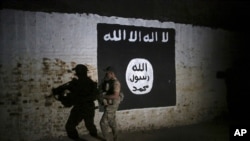The Islamic State terror group appears to be exploiting security gaps across Syria and Iraq to reposition its forces and help fuel an increase in violence that is reenergizing fighters and supporters.
Officials with U.S.-backed forces in northeastern Syria tell VOA the recent surge in violence across the region, including attacks on civil servants and execution-style killings at the al-Hol displaced persons camp, are linked to an influx of operatives from areas nominally under the control of Syrian President Bashar al-Assad as well as from neighboring Iraq.
The assessment of U.S. partners on the ground is consistent with Washington’s own findings in recent months, which warn that IS fighters and operatives enjoy freedom of movement across much of Syria while finding ways to shape the environment to the terror group’s advantage.
“ISIS is not finished yet,” Mazloum Abdi, the general commander of the U.S.-backed Syrian Democratic Forces (SDF), told VOA’s Kurdish service, using an acronym for the terror group.
The SDF has responded with a campaign of its own, using air support and intelligence from the U.S.-led coalition to track down and eliminate IS fighters.
Abdi told VOA the operations have resulted in numerous arrests.
One IS cell, blamed for the kidnapping and beheading of two women who worked for the SDF-aligned Autonomous Administration of North and East Syria, was nearly wiped out, he said. SDF personnel killed four of the alleged attackers and arrested a fifth, although another managed to escape.
Still, Abdi cautioned that even such SDF successes have not done much to deter IS.
“It has intensified its attacks,” he said. “The terror organization is trying to revive itself.”
Previous attempts to root out IS activity in some of the same hot spots, such as in the Badiyah desert along the Syrian-Iraqi border, also seemingly have managed to do little more than maintain a stalemate with IS fighters after early indications of success.
Abdi encouraged U.S. and coalition forces to help the SDF maintain a steady pace of operations against IS and to do more to support the local governments.
“If they provide support for the civil administration in our region, we can pursue a more effective campaign against the ISIS,” he said.
But there are questions as to whether such support will be sufficient, given the ability of IS to leverage a large base of support at displaced persons camps, like al-Hol.
According to the Syrian Democratic Council (SDC), the SDF’s political wing, at al-Hol alone more than 23 people have been killed since January, the majority of them at the hands of IS supporters.
“Most of these deaths, they are Iraqis, most of them, because they are working with the security forces inside the camp,” Sinam Mohamad, the SDC’s U.S. representative, told VOA.
And just as with the IS cells operating outside al-Hol, a series of arrests inside the camp has done little to deter IS activity.
“This is a very dangerous camp. It is very dangerous people who are living there,” Mohamad said. “They help these sleeper cells and support them.”
Mohamad and other officials say parts of the camp are essentially being run by the wives and other female relatives of IS fighters, who have formed Hisbah councils, which enforce IS’s religious edicts.
These officials claim intelligence gathered from those who have been arrested as part of security sweeps through al-Hol indicate IS supporters on the inside are getting instructions from the IS cells that have moved into the area.
U.S. officials caution that money and weapons have also been moving into the camp, which is now seen by IS supporters not just as a remnant of the terror group’s physical caliphate but as a new operational hub.
Other U.S. officials are raising concerns that al-Hol and camps like it are becoming part of a so-called “doomsday scenario,” serving as active incubators for the next generation of IS.
“It's a huge problem," John Godfrey, the State Department’s acting counterterrorism coordinator, told a virtual conference Wednesday. "We've seen incidents of radicalization in kids as young as 10 and 11 years of age."
The SDC’s Mohamad told VOA the situation for the children at al-Hol is precarious at best.
“We are afraid for these children who are with their mothers,” she said. “They are feeding them with this extremist [IS] ideology, and we don't know what will happen.”
Mutlu Civiroglu, VOA Kurdish Service, contributed to this report.
Editor's note: This story has been amended to clarify that IS supporters were behind the majority of killings at al-Hol.








